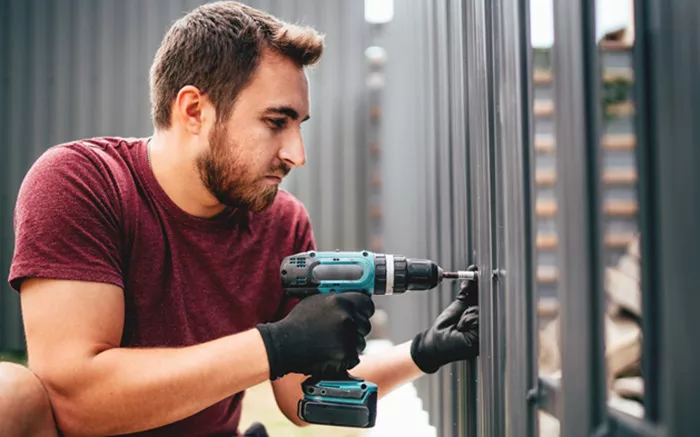Drilling through metal can seem daunting, but with the right tools, techniques, and safety precautions, it can be done effectively and safely. Whether you’re working on a DIY project or a professional job, this guide will help you achieve clean, precise holes in metal.
1. Choose the Right Drill Bit
High-Speed Steel (HSS) Bits
High-speed steel (HSS) bits are the most common type for drilling through metal. They are durable and versatile, making them suitable for a variety of metals such as aluminum, brass, and mild steel.
Cobalt Bits
For harder metals like stainless steel and cast iron, cobalt bits are ideal. They are more heat-resistant and can withstand the friction and heat generated when drilling harder materials.
Carbide-Tipped Bits
Carbide-tipped bits are extremely hard and can drill through very tough metals, including stainless steel and hardened steel. These bits are typically more expensive but offer exceptional performance and longevity.
2. Gather the Necessary Tools and Materials
Before you begin drilling, make sure you have the following tools and materials:
Drill: A variable speed drill is ideal for metal drilling as it allows you to control the speed and torque.
Lubricant: Cutting oil or lubricant helps to reduce friction and heat, prolonging the life of the drill bit and ensuring smoother drilling.
Center Punch: A center punch is used to mark the drilling spot and prevent the drill bit from wandering.
Clamps: To secure the metal piece and prevent it from moving during drilling.
Safety Gear: Safety glasses, gloves, and ear protection are essential to protect yourself from metal shavings and noise.
See also: How To Drill Into Brick?
3. Prepare the Metal Surface
Mark the Drilling Spot
Use a pencil or marker to mark the exact spot where you want to drill. Ensure the mark is clear and precise to avoid any mistakes.
Use a Center Punch
Place the center punch on the marked spot and strike it with a hammer to create a small indentation. This indentation will guide the drill bit and prevent it from slipping or wandering off the mark.
4. Secure the Metal Piece
Clamp the metal piece securely to a stable surface or workbench. Ensure it is firmly held in place to prevent movement during drilling, which can lead to inaccurate holes or damage to the metal.
5. Select the Right Drill Speed
Drilling through metal requires a slower drill speed compared to wood or plastic. Here are some general guidelines:
Soft Metals (Aluminum, Brass): Use a moderate speed.
Hard Metals (Steel, Stainless Steel): Use a slower speed to prevent overheating and bit dulling.
6. Apply Lubricant
Apply a few drops of cutting oil or lubricant to the marked drilling spot. Lubricant reduces friction, keeps the drill bit cool, and ensures a smoother drilling process. Reapply lubricant as needed throughout the drilling process.
See also: How To Drill Into Concrete?
7. Begin Drilling
Start with a Pilot Hole
For larger holes, it’s beneficial to start with a small pilot hole. Use a smaller drill bit to create an initial hole, which will guide the larger bit and make the process easier.
Drill the Hole
Align the Drill: Position the drill bit on the center-punched mark, ensuring it is perpendicular to the metal surface.
Apply Steady Pressure: Apply steady, moderate pressure as you drill. Avoid forcing the drill, as this can cause the bit to overheat or break.
Maintain Consistent Speed: Keep the drill at a consistent speed, adjusting as necessary based on the hardness of the metal.
Pause to Cool: Periodically pause to allow the drill bit to cool down and apply more lubricant if needed. This prevents overheating and prolongs the life of the bit.
8. Remove the Drill Bit
Once you’ve drilled through the metal, slowly retract the drill bit while keeping the drill running. This helps to remove any remaining metal shavings and ensures a clean exit hole.
9. Clean Up the Hole
Use a deburring tool, file, or sandpaper to remove any sharp edges or burrs around the hole. This step ensures a smooth, clean finish and reduces the risk of injury from sharp metal edges.
10. Safety Precautions
Wear Safety Gear: Always wear safety glasses, gloves, and ear protection to protect yourself from metal shavings and noise.
Secure the Workpiece: Ensure the metal piece is securely clamped to prevent movement during drilling.
Keep the Area Clean: Clean up metal shavings and debris promptly to prevent accidents and maintain a safe working environment.
Conclusion
Drilling through metal requires careful preparation, the right tools, and proper technique. By choosing the appropriate drill bit, securing the metal piece, using lubricant, and maintaining the correct drill speed, you can achieve precise and clean holes in various types of metal. Remember to prioritize safety throughout the process, and you’ll be able to tackle metal drilling projects with confidence and success.
Related Topics:

